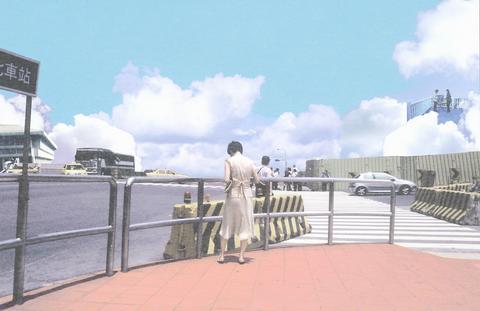The skywalk is gone; How can my two actors encounters each other? seems to be the question being asked by director Tsai Ming-liang (蔡明亮) in the sentimental short film, The Skywalk is Gone (天橋不見了), which will be screening at Taipei's Cinemark cinema at the Living Mall (京華城喜滿客) today.
This is the first time that a 22-minute short is having an independent cinema release.
For the director's many fans, the language of Tsai's films continues lucid and rich in this short work, even though Taipei remains a cheerless place and his characters rarely have a chance of happiness. He does not, however, cater so well for those coming to his work for the first time.

PHOTO COURTESY OF TSAI MING-LIANG
In fact, Skywalk is really an extension of What Time is it There? (
In What Time is it There? the female protagonist, Hsiang-chi (
She hangs around Taipei Railway Station and the Mitsukoshi Department store, walking aimlessly. She comes across a woman who drags a huge suitcase. Hsiang-chi follows her. Then both are stopped by a policeman for jay walking. The woman argues that she wanted to take the skywalk, but it is no longer there.
And Hsiang-chi continues searching for Hsiao-kang, but can find no trace of him.
For director Tsai, Taipei is a rapidly changing city. Every 10 years, old memories are wiped away and places acquire a new look. Perhaps it is not too much of a coincidence that each of Tsai's films have landmarks that have since disappeared.
"It seems that many places that I shot for my films have vanished. This is kind of worrying!" said Tsai jokingly.
It's self-referential natures makes Skywalk somewhat difficult to understand, but Tsai maintains high production values and the short film is filled with precise shots, beautiful photography and good performances.

This is the year that the demographic crisis will begin to impact people’s lives. This will create pressures on treatment and hiring of foreigners. Regardless of whatever technological breakthroughs happen, the real value will come from digesting and productively applying existing technologies in new and creative ways. INTRODUCING BASIC SERVICES BREAKDOWNS At some point soon, we will begin to witness a breakdown in basic services. Initially, it will be limited and sporadic, but the frequency and newsworthiness of the incidents will only continue to accelerate dramatically in the coming years. Here in central Taiwan, many basic services are severely understaffed, and

Jan. 5 to Jan. 11 Of the more than 3,000km of sugar railway that once criss-crossed central and southern Taiwan, just 16.1km remain in operation today. By the time Dafydd Fell began photographing the network in earnest in 1994, it was already well past its heyday. The system had been significantly cut back, leaving behind abandoned stations, rusting rolling stock and crumbling facilities. This reduction continued during the five years of his documentation, adding urgency to his task. As passenger services had already ceased by then, Fell had to wait for the sugarcane harvest season each year, which typically ran from

It is a soulful folk song, filled with feeling and history: A love-stricken young man tells God about his hopes and dreams of happiness. Generations of Uighurs, the Turkic ethnic minority in China’s Xinjiang region, have played it at parties and weddings. But today, if they download it, play it or share it online, they risk ending up in prison. Besh pede, a popular Uighur folk ballad, is among dozens of Uighur-language songs that have been deemed “problematic” by Xinjiang authorities, according to a recording of a meeting held by police and other local officials in the historic city of Kashgar in

It’s a good thing that 2025 is over. Yes, I fully expect we will look back on the year with nostalgia, once we have experienced this year and 2027. Traditionally at New Years much discourse is devoted to discussing what happened the previous year. Let’s have a look at what didn’t happen. Many bad things did not happen. The People’s Republic of China (PRC) did not attack Taiwan. We didn’t have a massive, destructive earthquake or drought. We didn’t have a major human pandemic. No widespread unemployment or other destructive social events. Nothing serious was done about Taiwan’s swelling birth rate catastrophe.